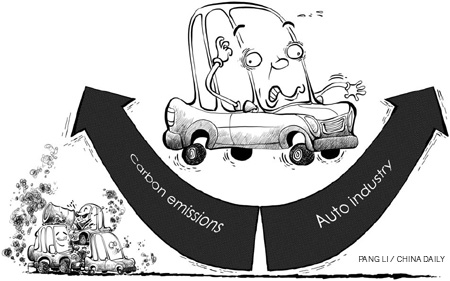 |
Large Medium Small |
|
 |
In the modern world, we cherish our freedom and individuality. And, as automobile advertisers have long understood, few experiences make us feel more liberated than a fast ride with the top down.
To be modern is to be mobile. Our economy depends on the free and rapid circulation of people and goods, and we have invented transportation technologies to suit our needs. First the railroads moved people and goods at previously unimaginable speeds, while steamships circled the globe. Then, in the 20th century, airplanes moved us even faster.
For most people, though, mobility means automobiles. Cars freed rural people from their isolation, and they gave city dwellers access to the countryside. The middle classes take their cars for granted, while the world's poor aspire to car ownership as a token and a tool of advancement.
But is our modern mobility sustainable? We are facing an energy crisis, a climate crisis, and an economic crisis - and perhaps a mobility crisis as well.
Sometime during the past two years, according to United Nations estimates, the world's population became mostly urban. For the first time, a majority of us now live in cities, and that majority will grow rapidly. But urban life poses a challenge to our automotive mobility. In cities, cars offer easy mobility - but only when traffic isn't too bad. They also free drivers from the delays and tribulations of buses, trains and sidewalks. In other words, a car furnishes a steel cocoon that shields motorists from their fellow citizens.
That protection comes at a price, if not a loss of civility, then certainly of urban mobility, as cars clog the roads. Individuals still find it worthwhile to drive through the city. But for the community as a whole, making enough room for all the cars means devoting a large part of the city to a costly network of highways and parking lots - which still can't keep up with the growing fleet of cars.
Amid road construction and honking horns, the vaunted freedom of the open road has long since vanished in the rear-view mirror. If we continue to fill our cities - not just London and Los Angeles, but also Mumbai and Shanghai - with cars, we will be left with little mobility and barely functional cities.
Which brings us to the state of the auto industry. Although the crisis of the American automobile manufacturers has many causes, its resolution may founder on the crisis of mobility.
The United States has always been the model of a mobile society, where people are willing to pull up stakes and go someplace new - if not to a new territory out west, then at least to a distant suburb, a long drive away from their old home. The US became the envy of the world not least because it was the first country where ordinary people owned cars, and it is still the land where people drive really big cars. It led the way in rebuilding its cities around cars and highways.
Even as the automobile business went global, the US car companies remained a breed apart. Although Ford and General Motors build small cars in Europe, they made their money at home by persuading urban dwellers to buy gas-guzzling behemoths that promised mastery of the open road. Detroit owes its century of remarkable success to the carmakers' skill in packaging practical mobility with improbable fantasy.
Those days may be over. The global economic crash came on the heels of the 2008 oil-price explosion, which proved to be short-lived but is likely to return as global oil supplies are stretched to the limit. New technologies like lithium batteries and hydrogen cars promise to free us from dependence on fossil fuels without separating us from our cars, but even the most remarkable breakthroughs cannot replace our automotive fleet anytime soon. By the time something comes along to supplant the cars that we know - and something will, eventually - we may have had the chance to rethink our dependence on them.
Few of us will voluntarily renounce our modern mobility. Yet the end of cheap oil - along with the recession - invites us to escape the burden of car loans, sell the second car, drive less, car-share, choose smaller vehicles, mass transit, bicycles or our feet, or move to walkable, transit-linked neighborhoods.
Economists, who blithely assume that pre-2008 automobile sales are "normal", because Americans "need" their cars, misunderstand the nature of the automobile market. Enormous cars, long commutes and vast parking lots do have their advantages, but we could manage to live without them.
And yet other countries' growing middle classes want to emulate the American dream - to be able to drive to the country and seal themselves off from city streets, just like Westerners. Most governments, too, are eagerly building highways and promoting domestic car industries.
Still, if trend-setting Westerners are increasingly bicycling, walking, and riding trains, perhaps wealthy Asians will follow suit, and perhaps their governments will begin to doubt that cars are the way of the future. It is difficult to imagine a world in which cars, and driving, are out of fashion. But it is bound to happen someday, and perhaps that day is not far off.
The author is writer of Autophobia: Love and Hate in the Automotive Age, and was a visiting professor of urban studies at the University of Oregon in 2009.
Project Syndicate.